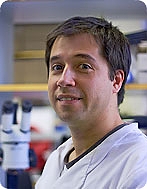Dr Pablo Henny joined the Unit in December 2006, and returned to his home country of Chile last month. As well as his appointment as an Assistant Professor at the Department of Anatomy, Faculty of Medicine, Universidad Católica de Chile in Santiago, he was also awarded a grant from National Commission for Scientific & Technological Research (FONDECYT). The funded for 3-years, the project is entitled "Anatomical, neurochemical and physiological characterisation of individual inhibitory neurons of the rat medullary reticular formation recorded and labelled in vivo, and their relevance for normal and pathological motor state control".
Dr. Henny explains the the aims of his project:This is a basic research project in neuroscience and its aim is to contribute to the understanding of the neuronal mechanisms responsible of the changes in motor activity that are observable across different sleep-wake states. These mechanisms allow posture and movement during wakefulness, as well as the decrease and absence of motor activity during different sleep states.
Knowing the neuronal circuits that underlie these changes is not only important to understand motor control from a biological point of view, but also to understand what happens when these mechanisms fail, resulting in disorders such as narcolepsy or REM sleep behaviour disorder, as well as the motor and sleep complications observed in a large number of patients suffering Parkinson's Disease, for instance.
We will study the medullary reticular formation, a brain region directly involved in muscle tone regulation. Using neuroanatomical and neurophysiological techniques, we will attempt to define the identity, activity and connections of individual neuron which may be involved in this process, using an anaesthesia model which resembles natural sleep states.
Everyone at the Unit wishes Pablo continued academic success, and much happiness with his growing family- his first child, Victor, was born only days before leaving for Chile.
